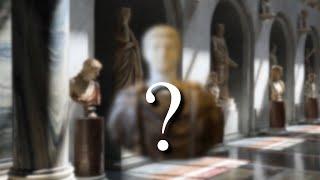
What Were The Last Statues Of The Roman Empire?
Комментарии:

Maybe someone else mentioned this, but if you look at Sassanid Persian statues (which roughly correspond to the same late-Roman period) you’ll see that they’re stylistically identical to the late-Roman statues.
So perhaps there was an influx of Sasanian influence on the Roman Empire. After the imperial period, maybe the tradesmen learned to carve from Sasanian artisans and that style became prominent over the more detailed examples from earlier periods. Heck, the artisans very well could’ve been Persian for all we know. Maybe they traveled to Rome from Persia to make a living.
In particular, the Sasanian style uses that same big-eye look on all their statues.
To me, this makes sense. I believe Persian influence is responsible, in addition to a general decline in artistry.

This was profoundly scholarly and niche important. Bravo.
Ответить
Be careful here, Maiorianus; it's always worth bearing in mind how other cultures (in exactly the same centuries) also changed and evolved as well. It's no good just looking at the case of Roman art, through its evolution, without looking at how other cultures (either in the west or the east) also continued to evolve - in their own ways - through exactly the same centuries. If, for example, we looked at much of the art of the 20th century (Picasso, etc) we'd probably conclude there was a big "decline" from the art of the 19th century - but it's just a change in tastes.
Ответить
Another great video and very thought provoking, thanks. To echo many of the comments below i think the decline in detail must be a combination of upheaval and breakdown of artists income stream, but also a change in artistic style.
Ответить
Amazing Vídeo.
Ответить
Emperor Heraclius Was The Last to invest in Statues And Busts.
Ответить
It would be interesting to see a selection of statues from the time of the Roman Republic.
Ответить
Suggestion for video:
Instead of assuming the Fall Of Rome was a tragedy,
could you do a video on who benefited from the end of the Western Empire?
1. The Catholic Church accrued much more power in the absence of a Roman Federal Government,
stepping into the vacuum as the universal arbiter of European affairs.
2. Minorities.
For example, didn't Arians and Jews benefit from the far more tolerant Germanic rulers,
at least for a few centuries?
3. Provincials.
Didn't they benefit from local rule, even if it was under Germans, rather than a remote emperor, his heavy taxes,
and the disruption of civil wars and barbarian invasions?
4. Germans.
Instead of living in tribal groups, under threat from steppe marauders and Rome itself,
Germans became downright civilized, prosperous, and effective regional suzerains.

I think this concentrates too much on the loss of technical skill, which is also talked about in 2D art forms such as paintings between the Classical World and the Medieval World. We need to also talk about the shift in the mainstream artistic aesthetic of the time, especially with regards to how society as a whole approached art with the proliferation of Christianity. Let's not forget about iconoclasm, after all. It's like saying that painters like Van Gogh or Monet or Picasso had lost the technical skills found in the Renaissance because their art was less realistic and true to life. It's not that any technical skill was lost. It's that artistic aesthetics had shifted away from the realism of earlier time periods. And we can see we still can create very realistic art not only in that time period (such as with the famous Portrait of Madame X), but also today, with the recent hyper-realist movement. It's just that aesthetics change.
Ответить
they removed the noses on almost every statue they could find even the sphinx in Egypt was not safe .it is kind of impressive how they left their mark on history even if its in a bad way
Ответить
Very interesting!
Ответить
There's a statue of one of the Umayyad caliphs and it's ugly
Ответить
Jew: Alright, Greek, pay close attention. Look at your marble. Visualize the sculpture within. And gently... [hits marble with chisel; it breaks into a pile of rubble]
Roman: [hits marble with chisel and it becomes a perfect sculpture of Michelangelo's David] How's this Jew ?
Jew [starry-eyed] It's beautiful! [a tear falls from his eyes; snaps out of it] I mean... Wrong .idolatry is the ultimate betrayal of God's relationship with humanity. [Romans lip starts quivering] You've got to go by the book. Follow the rules. [Roman wipes away a tear] Besides, you've got the nose wrong [ put new nose on the statue and it crumbles]
Roman: Ohhh, it's so obvious. I would've never thought of that. I'm sorry, Jew. I came here to learn and I arrogantly shunned your lessons. [falls down and starts crying] I'll never be a great artist like you! I don't deserve your tutoring. I don't deserve to be in your presence Don't look at me Don't look at my shame. These hands weren't meant to create. They only destroy. I can't look at them!

kinda like today's movies
Ответить
I'm not convinced it is completely a case of artists losing the technical skills of the earlier eras, but also a case of the style changing. A thousand years from now, a future historian would look at "modern" art, which is often quite deliberately made ugly if not made of literal garbage, and conclude that 20th and 21st century artists had lost the skill to make beautiful Renaissance art-when they had simply rejected it.
Ответить
Dark-Age deniers shall have to work hard on this
Ответить
I find every video on the late roman period to be melancholy. Imagine how dire it would be to be living at that time and seeing everything falling apart around you....
Ответить
And sculptures didn't get better until the Renaissance! If busts of American 'leaders', billionaires, politicians, hedge-fund managers, judges, mayors, etc. -- if they were sculpted today, future historians (if any) would be equally repulsed.
Ответить
I suppose it begs the question, how did the craftsmanship of the Renaissance re-emerge? We are much more informed about how they trained then, from master to apprenticeship at a very young age, I wonder if this is a requirement for the mastery of this difficult craft. Is it known if the Romans follow this structure?
Ответить
Current cultural production seems to suggest we're entering a new dark age; except this time and for the first time in known history, our "elites" are making sure there won't be any come back by destroying the biological basis of greatness.
Ответить
Was it given up or were these statues demolished by barbarians?
Ответить
Different number of dimensions in the representation, I realise, but why am I reminded of the 'interesting' 2012 'restoration' of Elías García Martínez's "Ecce Homo" fresco in Santiario de Misericordia, Borja, España?
Of course, Constantinople had something resembling a valid excuse from 726CE, with the onset of iconoclasm.

The statues of the early roman era look happy and relaxed while the later statues from 500 after look like they are angry and hated even broken stressed ugly. Must be climate change😄
Ответить
Christians were suspicious of sculpture due to the prohibition against idolatry. The uglier (less realistic) the statue the less likely it would be to become the subject of idolatry.
Ответить
Nightmare fuel.
Ответить
Haven’t we seen the same decline in western art?
Ответить
Here's the thing that bothers me about ancient western statuary as a whole, and it's how ugly all the females are, no matter the era. They all have stout manly shapes with horrible boobs mounted on them, and the same homely squared facial features. There's no doubt there were MANY beautiful women around, and you'd think that at some point an artist would actually want to capture that, but they just never did. Just see Indian sculpture from the same period. The women are shapely and buxom and beautiful.
The only example I can think of in ancient western statuary where an actual beautiful woman was sculpted, would be the bust of the woman from Rome with the very big and elaborate hair do. She's slender and shapely with a beautiful face, which is just proof they were around. So weird how non-existent they are from actual artisans that you'd think would enjoy featuring them.

I have been studying Roman military history for over 50 years and I appreciate your dedication to this subject.
Thank you friend.

It is also interesting why they started making them again in the late medieval/renaissance era.
I think there was also a lack of demand hence less specialists ans therefore more decline in general. No more masters with apprentices

Art reflects the level of a culture. Rome at its zenith: great, skilled art. Rome in its decadent decline: abstract, crude garbage...let's be real. Similar to the U.S.: 1940's: Stuart Kelly, Grant Wood. Norman Rockwell. Now: Pollack. Haring, Basquiat. Civilization in decline, imo. Good vid.
Ответить
Really fascinating video! A few of the later pieces are quite forceful, almost as if their makers were able to compensate for the decline in realistic representation. Perhaps the makers didn't even care about the declining realism!
Ответить
Will the art about Roman mosaic be covered as well in the future? And is it more expensive or cheapter than making statues?
Ответить
Late twentieth century hollywood vs 2020 hollywood
Ответить
Yes, the skill and craftsmanship of the sculptors declined, but artistic style changed also. Comparing Rembrandt to Pollack, for example, might cause a future archeologist to conclude civilization collapsed.
Ответить
Day 1 of Asking Maiorianus to make a indepth video of Augusta Treverorum like the one of Lutetia Parisiorum
Ответить
They look like archaic greek art from 600 BC.
Ответить
Really good video, I actually haven't seen some of these statues before, which was neat to see. Especially that battered one, probably of a Ostrogothic King.
I'd be a bit careful in seeing the stylistic choices here as signs of a decline in craftsmanship though. Some of these statues are clearly meant to be stylized, and not realistic. Which was a growing artistic trend since the Tetrarchy (See the bust of Galerius for instance, or Maximian, neither of which look very realistic). Some of these are for sure of poor quality, but others are probably not trying to look realistic, which as you pointed out, skilled artists were still able to accomplish if they wanted to (like with the head of Justinian).
I actually like the look of these statues personally. They're weird and unexpected. They give off a kind of mysterious vibe too, since they're so rare and fragmentary. There's thousands of classical (and neo-classical) statues out there that all look the same, so I think these weird late antique ones are refreshing and unique for their unusual traits.

fascinating
Ответить
👍👍👍
Ответить
Hypothesis: this might be one area where the rise of Christianity had an effect. Romans understood virtue as an inherently civic, public quality. An individual had a social and public role to fulfil; it was not enough to be “privately good”. Roman aristocrats demonstrated this by lavishly spending on e.g. public works, statues, monuments, theatres, infrastructure etc, which would demonstrate their virtue and generosity, and ensure their legacy was remembered. This plausibly ensured that there was always strong demand for, among other things, skilled stonemasons capable of crafting impressive statues. Christianity shifted the incentives towards private charity; wealthy aristocrats still gave away a lot of money, but most to the church. Of course, the church would eventually become a great patron, but at least in this early period statues celebrating the human form seem to have been viewed as a bit too worldly and pagan. So plausibly demand for quality sculptors collapsed -- it was no longer a lucrative profession in high demand, leading to a rapid loss of this particular skill. I would be curious to know if the historical record bears that out.
Ответить
"Remarkable loss of craftsmanship", just like some 20th Century art based on ideas and not skill - art made for money laundering. Everyone has ideas, but not everyone has skill and craftsmanship.
Ответить


























